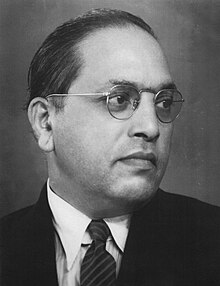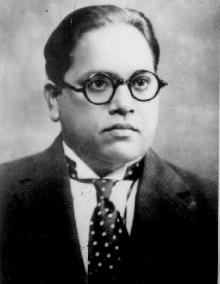Bhimrao Ramji Ambedkar
Bhimrao Ramji Ambedkar ( Marathi भीमराव रामजी आंबेडकर ; born April 14, 1891 in Mhow ; † December 6, 1956 in Delhi ), usually abbreviated to B. R. Ambedkar , also known by his honorary name Babasaheb Ambedkar , was an Indian lawyer, politician and social reformer. As a member of the Mahar, a population group that lives mainly in Maharashtra and the neighboring states and is traditionally counted among the Dalits , Ambedkar fought against social discrimination through the system of categorizing Hindu society into fourVarnas and the caste system . In 1956 he converted to Buddhism , triggering a mass conversion of hundreds of thousands of Dalits. In a poll carried out on behalf of History TV18 and CNN IBN as to who is the greatest Indian after Gandhi , B. R. Ambedkar received the most votes in July 2012.
Childhood and school days
Ambedkar was born in Mhow, a military base established by the British in Madhya Pradesh , as the fourteenth and last child of Ramji Maloji Sakpal and Bhimabai. His family belonged to the Mahar caste , which is one of the untouchable castes. The family came from the town of Ambavade in Maharashtra . The father left the army in the rank of subedar , a rank between NCOs and officers introduced in the Indian Army in British India. In 1894, after leaving the army, the father settled in Dapoli in Maharashtra. With reference to his military rank, the father managed to get his sons to attend the government-sponsored school. Ambedkar reports on his experiences at school as a member of a caste of the Untouchables in notes that he wrote in the 1930s. In the classroom, he had to sit alone in a corner on a cloth that he had to bring and wash himself, since the service staff who were responsible for cleaning the school did not clean anything he had touched. The classmates from the higher boxes were allowed to drink from the water pipe when they were thirsty. As an untouchable person, he was not allowed to touch the tap and could only drink if a worker was present who could bring him water. The path to higher education was only open to him when a brahmin teacher, who recognized the young man's talent, offered him the use of the brahmin surname Ambedkar instead of his original surname Ambavadekar, which was derived from the place where his family came from.
Study and training
In 1912, thanks to a grant from the Maharaja of Baroda , Sayaji Rao III. Gaekwad, in Bombay (today: Mumbai ) at the renowned Elphinstone College . He completed his studies there with a Bachelor of Arts degree .
Further scholarships enabled him to continue his academic training. He first studied economics and law at Columbia University in New York . He wrote his master's thesis on the caste system . The Ph.D. he earned with a thesis on the financial system in the provinces of British India . The American philosopher and educator John Dewey , who was teaching at Columbia University at the same time , had a great influence on him .
He then went to London enrolled in Gray's Inn , one of the English bar associations, as a lawyer and began another doctoral thesis at the London School of Economics .
On April 25, 1921, Ambedkar submitted an application for matriculation for the University of Bonn to the Ministry of Science, Art and Education in Berlin, but never began studying in Bonn.
Working in India
In 1923 Ambedkar returned to India as a lawyer after his fellowship had expired . Professionally, he initially held the office of finance minister in the State of Baroda and became a professor of economics. Finally after two years he took on the concerns of the Dalits, as the untouchables of Hindu society are called. Another name for the Dalits is the name Harijan , which goes back to Mahatma Gandhi (in the West translated imprecisely as "children of God", actually: "Vishnu-born"). Ambedkar preferred the term "Dalit", which, in contrast to "Harijan", is a name used by the untouchable castes and contains a combative element.
Since Dalits did not have equal access to public facilities in practice, Ambedkar led thousands of them in a protest march in March 1927 to the Chowdar Water Reservoir to drink water. Kastenhindus then carried out extensive cleansing rituals. Ambedkar now tried to take legal action, which only led to success after ten years, which led him to the conviction that one could not limit himself to that if one wanted to improve the miserable situation of the Dalits. In May 1936 he described turning away from Hinduism as an essential element of liberation. Until 1956 he carried out research on the liberation potential of religions, especially Buddhism , Christianity and Islam .
In 1947 the now recognized political and spiritual leader of the Dalits became Minister of Justice of the first government of independent India . He chaired the constitutional committee and was instrumental in drafting the Indian constitution , of which he is seen as the real "father". In 1951 he resigned as minister after he had to realize that the Hindu ruling class was not ready to fully comply with his demands for social, economic and political equality for the Dalits.
On October 14, 1956, Ambedkar in Nagpur converted to Buddhism together with around 388,000 untouchables in a large ceremony by taking refuge three times , as historical reports say, a little more than 2200 years ago in the same place on the same day great Ashoka had done. At this point the Deekshabhoomi was built. In the teachings of the Buddha he saw a caste system rejecting and rational, even social revolutionary religion, whose ethics are based on the principles of equality, freedom and goodness.
In the following years the number of converts increased to about 6 million. The Ambedkar movement thus brought about a revival of Buddhism in India, which began in the 4th century BC. Until the 8th / 9th Century AD was the leading spiritual force on the Indian subcontinent , but was then largely displaced from its area of origin in the course of a Brahmanic counter-mission (from the 8th century) and the Islamic conquest of India (12th / 14th century).
Although India is a predominantly Hindu country, on the initiative of Ambedkar the symbol of Buddhism, the “wheel of teaching” ( dharmacakra ) , was included in the national flag of India , meanwhile the famous “lion capital” of the Buddhist emperor Ashoka (approx. 268–232 BC) . Chr.) Was chosen as the national coat of arms of the Indian Republic .
Ambedkar died just a few months after his conversion to Buddhism on December 6, 1956. In April 1990 he was posthumously awarded the " Bharat Ratna " (German Jewel of India ) Order of Merit, the highest honor of the Indian Republic.
The "Society for Popular Education" established by Ambedkar with numerous educational institutions and the "Buddhist Society of India" continue his work. There are around 10 million Buddhists living in India again today.
Fonts
-
Annihilation of Caste. [Critical annotated new edition with the text corrections made by the author in the 2nd edition 1937 and 3rd edition 1944. Edited by S. Anand, with an introductory essay by the Indian writer Arundhati Roy ].
- Indian edition: Navayana, New Delhi 2014, ISBN 978-8189059637 .
- English-American edition: Verso, London & Brooklyn 2014, ISBN 978-1-78168-831-1 (print), ISBN 978-1-78168-832-8 (eBook USA), ISBN 978-1-78168-830- 4 (eBook GB).
- German translation: The extinction of the box system. Draupadi Verlag, Heidelberg, 2019, ISBN 978-3-945191-46-0 .
literature
- Martin Baumann: Neo-Buddhist concepts in India and England: On the 100th birthday of BhimraoRamji Ambedkar. In: Zeitschrift für Religions- und Geistesgeschichte 43, No. 2 (1991), pp. 97–116.
- Johannes Beltz: Mahar, Buddhist and Dalit . Manohar Publishers, New Delhi 2005.
- S. Jondhale, Johannes Beltz (Ed.): Reconstructing the World. BR Ambedkar and Buddhism in India . Oxford University Press, New Delhi 2004.
- Dhananjay Keer: Dr. Ambedkar. Life and Mission . Popular Prakashan, Bombay, 2005 reprint, ISBN 81-7154-237-9 .
- Ramachandra Guha: Makers of Modern India . Chapter 9: BR Ambedkar. The Annihilator of Caste and Chapter 14: BR Ambedkar. The Wise Democrat . Viking, New Delhi 2010, pp. 204-227 and pp. 313-325.
- Eleanor Zelliot: The Leadership of Babasaheb Ambedkar. In: From Untouchable to Dalit. Essays on the Ambedkar Movement . Manohar Publications and Distributors, Delhi 1998 (Reprint), pp. 53-78.
- Arun Shourie : Worshiping False Gods: Ambedkar and the Facts that have Been Erased. Rupa Publications, Delhi, 2005.
- Martha Craven Nussbaum: Ambedkar and the fight against the caste system. In: dies .: Political Emotions: Why Love Is Important for Justice. Suhrkamp, Berlin 2014, ISBN 978-3-518-58609-9 , pp. 548-557.
- Bimrao Remdschi Ambedkar , in: Internationales Biographisches Archiv 06/1957 from January 28, 1957, in the Munzinger archive ( beginning of article freely available)
Web links
- Literature by and about Bhimrao Ramji Ambedkar in the catalog of the German National Library
- Entry on the homepage of the Rajya Sabha
- Dr. Babasaheb Ambedkar A Dalit-Bahujan Media (English)
- Brigitte Voykowitsch: "The broken people": Fight for human rights - the Dalits in India. In: Commune. Forum for politics, economy, culture. Kühl-Verlag, Frankfurt / Main, October 2000, archived from the original on July 24, 2017 (reproduced on oeko-net.de).
- Walter Hahn: Dr. Bhimrao Ramji Ambedkar - the idol and the bearer of hope of the Dalits. In: Platform “Dalit Solidarity in Germany” (DSiD). March 27, 2005, archived from the original on December 22, 2006 .
- Maren Bellwinkel-Schempp (author), Peter Schalk (ed.): Bhakti and Buddhism, in New Buddhism as a social draft. (pdf, 15.1 MB) Upsala Universitet, 2007, pp. 187-233 .
- The importance of Ambedkar for the Dalit. In: ems-online.org . Archived from the original on February 17, 2005 .
- Edmund Weber: Ambedkar's Neo-Buddhism and its relationship to the Hindu Dharma. (pdf, 112 kB) In: Journal of Religious Culture / Journal für Religionskultur 18a. Institute for Scientific Irenics at the Johann Wolfgang Goethe University Frankfurt am Main, 1998 .
- Dalits in conversion ceremony. In: BBC News . October 14, 2006(English).
- Maren Bellwinkel-Schempp: The importance of Ambedkar for the emancipation of the untouchable. Gandhi and Ambedkar. (pdf, 139 kB) In: Platform “Dalit Solidarity in Germany” (DSiD).
Individual evidence
- ↑ Uttam Sengupta: A Measure Of The Man. In: Outlook Magazine. August 20, 2012, accessed January 26, 2020 .
- ↑ * in the 1890's * - The Struggle For An Education. Columbia University New York, accessed July 22, 2014 .
- ↑ Bhimrao Ramji Ambedkar (author), Frances Pritchett (ed.): Waiting for a Visa. In: Columbia.edu. Archived from the original on June 24, 2010 ; accessed on July 22, 2014 .
- ↑ Ramachandra Guha: Makers of Modern India. Viking 2010, p. 204 f.
- ↑ Maren Bellwinkel-Schempp: Ambedkar in Bonn - The first Western educated Dalit. (PDF; 249 kB) In: Südasien, Zeitschrift des Südasien Büro, No. 3/2010. Pp. 62–65 , accessed July 22, 2014 .
- ↑ Pamela Toler: Dr. BR Ambedkar: Untouchable, Reformer, Founding Father. In: Wonders & Marvels. August 2014, accessed May 30, 2017 .
| personal data | |
|---|---|
| SURNAME | Ambedkar, Bhimrao Ramji |
| ALTERNATIVE NAMES | Babasaheb (honorary name); Bhimrao Ramji Subedar (maiden name) |
| BRIEF DESCRIPTION | Indian politician and social reformer |
| DATE OF BIRTH | April 14, 1891 |
| PLACE OF BIRTH | Mhow , Indore District , Madhya Pradesh |
| DATE OF DEATH | December 6, 1956 |
| PLACE OF DEATH | Delhi |



